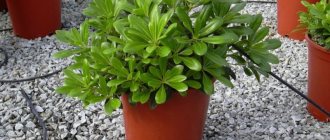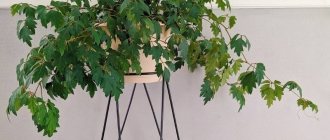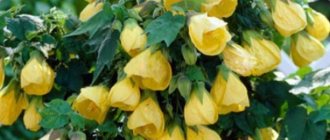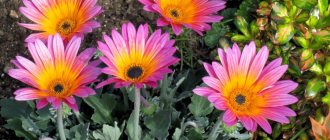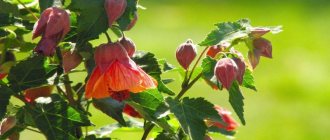Calibrachoa
Calibrachoa has significant external similarities to petunia, but they are different plants with different DNA structures. Calibrachoa is distinguished by a large number of small flowers with a “throat” of brown or yellow shades. The stem is branched, strong, with short hairs, early woody. The leaves are small and covered with hairs. Plant of ampelous type.
The following varieties have been developed by breeders:
- "Coral pink";
- "Kalita snow-white";
- "Cherry Star";
- "Apricot Punch";
- "Pink Chiffon";
- "Grape Punch"
Learn more about how to plant and grow Calibrachoa flowers.
Minitunia
Minitunia is similar to petunia, only the small tiny flowers are so tiny that they cannot be confused with anything else. The plant is not tall, grows strongly and branches, forms strong shoots that are resistant to brittleness. Due to the abundance of buds forming on one bush, it resembles a colored cloud. Used in hanging flowerpots, as a groundcover and border plant.
[adsp-pro-4]
The most popular varieties:
- "Rose";
- "Rose Vane";
- "Blue Storm";
- "Ivory";
- "Coral Crash".
Caring for Calibrachoa
Calibrachoa is easy to grow at home. In open ground they should be protected from frequent rains. The soil should not be too dry or too wet. The plant is watered moderately, always when the soil is dry. When watering, you can add acidifying fertilizers to the water. It is very important not to overwater the plant. The symptoms of overwatering are very similar to the symptoms of drying out due to low humidity, and they are often confused. The leaves soften and curl, as is the case when a flower is dry. In such a situation, check whether the pot is heavy. It may be that the drain holes to remove excess water are clogged and need to be cleared.
Like other plants that bloom profusely, calibrachoa requires systematic feeding. These can be fertilizers intended for petunias, surfinia, or compositions intended for feeding flowering balcony plants. Flower growers who do not have experience working with water-soluble fertilizers are recommended the following rule: 1 teaspoon of the composition per 1 liter of water. Water with this solution every 7 days.
This way we will avoid over-fertilizing young plants. During the full season, you can increase the dose or frequency. When growing calibrachoa, it is also worth using formulations with iron (iron chelate) to spray the bushes. The use of iron chelate helps protect leaves from chlorosis and enhances their green color (provided the flowers are grown in an environment with a slightly acidic or acidic pH).
Mirabilis
A plant of the Nyctaginaceae family called Mirabilis is a branching bush with ovate-elongated paired leaves. It has a unique feature - flowers of different colors may appear on one seedling, which bloom at night and fade by morning.
The flowers are fragrant, solitary, varied in color: from pastel to bright, one-, two- or three-color. The uniqueness of the flower is the absence of a corolla. The plant prefers sunlight and windless areas, fertile soil.
Of the 60 species, the Mexican mirabilis jalapa is widespread, several of its varieties are:
- "Iolanta";
- "Elvira";
- "Red Lollipop";
- "Mirabilis Serenade";
- "Mirabilis marble."
Read how to grow a Mirabilis plant in open ground.
Description of varieties
- Calibrachoa. Petunia is very similar to Calibrachoa, but if you look at the flowers more carefully, you can see their differences, and they differ even at the level of DNA structure. The branching of the stems is increased, and they become woody early, which affects their aesthetic appearance. In Calibrachoa, flower petals are more rounded and the middle of the flower is more pronounced, while every millimeter of the stem is strewn with such bells. Calibrachoa is grown in a hanging form.
- Minitunia. Breeders have developed a petunia hybrid with miniature inflorescences. This plant is short in stature, but its shoots are strong and branched, which prevents them from becoming brittle. Due to the fact that the abundance of flowering buds completely hides the branches, minitunia becomes like clouds of pink, blue, yellow, which can be used as bright landscape accents. The plant looks good in pots, as well as as a border or ground cover. Small petunia can also be called that.
- Mirabilis. This flower is interesting because buds of different colors can appear on one shoot, but they bloom by night, and by morning their beauty has already evaporated, as they wither. Mirabilis has a persistent aroma and comes in both bright and pastel colors.
- Surfinia. This is also a hybrid of petunia, but surfinia is distinguished by longer flowering and increased branching of stems.
- Morning glory. This flower belongs to the Convolvulaceae. The buds look like small gramophones, the branches can reach five meters. You need to pay attention to the fact that the flower is poisonous, and if it grows unattended, it begins to choke its neighbors.
- Datura. Datura, like petunia, is a relative of potatoes, that is, nightshades. The flowers are the same shape as morning glory, but they are quite large and the stem reaches about 1 meter and is erect. The plant is poisonous not only when touched - even if you inhale the aroma, you can be poisoned.
- Lavatera. A relative of mallow, lavatera has luxurious hair of delicate shades. Large flowers are collected in inflorescences in the form of a spikelet. But, as befits any beauty, the plant is capricious and demanding.
- Brugmansia. A beautifully flowering and spectacular plant, the petals of which can be of the following colors: cream;
- yellow;
- scarlet;
- blue. But it is worth remembering that this plant has a strong toxic effect.
- Fragrant tobacco. A tobacco bush will not only decorate the area, but will also repel pests that will head towards the garden. At the same time, the plant is decorated with large white inflorescences, and it does not require special care.
- Thunbergia grandiflora. This is a vine that can stretch up to six meters, it is not susceptible to disease, but requires strong support underneath. Thunbergia inflorescences shimmer in orange, crimson and yellow hues.
- Kampsis. Multi-colored gramophones are collected in large erect inflorescences. Such a bush requires space, because its height, if there is a good trellis, can reach 15 meters. These amazing flowers cascade down, forming thickets strewn with thousands of buds. But we must remember that the plant loves warm climates and is unlikely to survive in areas with low temperatures.
- Indoor syningias. Siningias have buds with velvety petals; this plant is grown in pots at home, but in the summer they can be moved outside.
- Streptocarpus. Streptokarus are able to present the gardener with up to hundreds of blossoming buds at the same time. They have no stem, the leaves are small and wrinkled, the color of the petals can be variegated or simply plain.
- Phlox drummond. An annual low-growing shrub whose inflorescences come in a variety of colors.
Surfinia
The effectiveness of this hanging plant, which is considered a petunia hybrid, amazes many gardeners. Long, powerful stems and abundant flowering are the distinctive characteristics of surfinia.
[adsp-pro-5]
The color range is represented by a wide palette from white to purple. The flowers are bright and form a blooming ball. Today there are more than 20 varieties of surfinia.
Particularly popular:
- "Hot Pink";
- "Table White";
- "Yelou";
- "Giant Parple";
- "Surfinia Red".
We offer you to read an article about the care and cultivation of the Surfinia hybrid.
Pelargonium thyroid (ivy leaf)
An excellent replacement for petunia can be Pelargonium thyroid, which is better known as Pelargonium ivy-leaved. The perennial received this name for the shape of its leaves, reminiscent of ivy.
This flower has recently been increasingly used to decorate balconies, terraces, and windows, because... it grows well in containers and hanging pots, is easy to care for and blooms for quite a long time. Pelargonium has long (up to 1 m) shoots and umbrella inflorescences with flowers of a wide variety of shades - from white to dark cherry.
Ivy-leaved pelargonium is propagated by seeds and cuttings. Both methods are not particularly difficult, but when propagated by cuttings, you will be able to admire the flowering earlier. Cuttings (8-12 cm long) are cut from the upper parts of the plant in February - March. Leave the cut cuttings in the fresh air for several hours to dry the cut. After this, dip them in any root formation stimulator, for example Kornevin, and plant them in the prepared substrate.
The soil for ivy-leaved pelargonium should be light and fertile. If you compose it yourself, then take the following components in equal proportions:
- leaf soil;
- turf land;
- peat;
- humus.
Be sure to place a layer of drainage at the bottom of the pot. The fact is that one of the weakest points of ivy-leaved pelargonium is its attitude to watering. It does not tolerate both excess and lack of moisture. However, drought is still less destructive for a plant than constant waterlogging, so take care in advance to drain excess water from the container.
It is not recommended to wash or spray pelargonium. Water that gets on the leaves can cause them to rot.
Feeding abundantly flowering plants, especially those that grow in limited space, is extremely necessary - and ivy-leaved pelargonium is no exception. During flowering, feed the flower once every 10-14 days with liquid potassium-phosphorus fertilizer. With its help, it will be possible to increase the duration and improve the quality of flowering.
Pelargonium ivy is native to Africa, so it easily tolerates hot weather and grows well in sunny places. However, if the air temperature approaches 30°C, then it is better to move the plant to partial shade.
When cold weather sets in, bring the plant into a room with a temperature of 14-15°C, reduce fertilizing (to once a month) and watering (to once a month). In such conditions, keep the flower all winter, and from the beginning of spring, begin to gradually accustom it to the sun and warmth.
morning glory
Morning glory is a genus of plants in the bindweed family. Poisonous climbing vine (up to 5 meters) with heart-shaped leaves, large funnel-shaped flowers of various shades. Morning glory gramophone flowers vaguely resemble petunia. The most common genus is the sweet potato morning glory, which includes five hundred species.
Of the 500, twenty-five are used in floriculture, the most popular of which are:
- "Ipomoea Cairo";
- "Ipomoea sky blue";
- "Ipomoea purpurea";
- "Ipomoea Nile";
- "Ipomoea moonflower."
Find out more about growing perennial Morning Glory outdoors.
Datura
Datura is a genus of plants in the nightshade family. An annual plant with a bare erect stem, about 1 meter high, forms a bright bush with huge gramophone flowers.
Datura leaves differ from petunia leaves in that they have dark green and lighter shades. The flowers are solitary, large, located in the forks of the stem. The flower is unpretentious, but responds gratefully with abundant flowering on fertile soil.
Attention. Datura is a poisonous plant that can intoxicate. Symptoms of poisoning may occur with prolonged close contact.
Varieties that are relevant to gardeners:
- "Common Datura";
- "Indian Datura";
- "Brugmansia";
- "Datura blizzard."
Read about how to grow dope from seeds in your garden.
Fuchsia ampelous
Another plant that can replace petunia has similar requirements for growing conditions - ampelous fuchsia. The ampel variety of fuchsia was bred by breeders relatively recently, so it is still little known to flower growers. However, I think there is still a lot ahead for this flower.
High humidity levels and partial shade are the basic rules that must be followed when growing ampelous fuchsia. Water the plant as soon as the top layer of soil dries out. When planting, make sure there is a layer of drainage at the bottom of the pot to prevent root rot. During periods of drought, don't forget to give your beauty a regular shower to help her survive the adverse conditions.
Another important point in caring for hanging fuchsia is pruning. The plant is pruned for the first time in the spring to give it a beautiful shape. To do this, shorten all shoots of overwintered fuchsia by a third. Then, throughout the entire flowering period (it lasts several months, from May to October), regularly pinch the stems so that the bush is lush and dense.
The next prerequisite for abundant flowering of ampelous fuchsia is fertilizing. From the beginning of flowering until September, once every 10-14 days, feed the plant with liquid complex fertilizer for flowering plants. In September, stop feeding to prepare the flower for the dormant period.
The easiest way to propagate ampelous fuchsia is by cuttings. To do this, in the spring, cut green cuttings (woody shoots take root very poorly) and place them in water. After the roots appear, the cuttings can be immediately planted in the ground.
Lavatera
Delicate pink, white and purple flowers with a silky tint make it difficult to confuse Lavatera with any other garden plant, even petunia. These are malt varieties. The leaves are spade, have hairs, the flowers are large, the buds create spikelet inflorescences.
[adsp-pro-6]
Has a long flowering period. The whole advantage of this flower is that it is not picky about the soil and is resistant to drought and wind.
Florists use two types:
- Lavatera annual (Silver Cap, Mont Blanc, Lovelines, Pink Beauty, Ruby Queen).
- Lavatera perennial (Lilak, Lady Bregon, Springs, Burgundy Vine, IKatcher).
We invite you to read an article about how to grow Lavatera from seeds on your own plot.
Requirements for soil and planting site of calibrachoa
Although calibrachoa has smaller flowers than petunia, it is no less decorative and easier to grow. The calibrachoa flower, due to its origin (a plant native to rocky areas), is more resistant to adverse conditions than petunias. It grows well and blooms profusely in a sunny or well-lit location, but can also be grown in light partial shade.
Calibrachoa prefers a fertile, permeable substrate with an acidic to slightly acidic pH (5-5.5 pH), but will also cope with regular flower soil. Like petunia, it requires a constantly moist substrate, but it tolerates the vagaries of the weather better (rain, wind, heat, temperature fluctuations). The flower should be sown in pots with good water flow and drainage; the roots are quite sensitive to waterlogging and may suffer from fungal diseases that cause root rot.
Brugmansia
Brugmansia is a genus of plants from the nightshade family. In summer it is covered with an abundance of flowers, which are called “angel trumpets”.
Attention! This is a poisonous shrub. The abundance and intensity of its aroma causes headaches, and toxic substances cause hallucinations.
Stems are woody, covered with smooth bark. The main asset of the plant is its spectacular flowers. The petals can be of various shades: white, cream, scarlet, yellow, blue.
Popular varieties:
- "Fragrant Brugmansia";
- "Golden";
- "Snow White";
- "Bloody";
- "Colorful Brugmansia"
Read about growing Brugmansia in open ground.
Fragrant tobacco
Tobacco is a genus of perennial and annual plants of the nightshade family. The bush is erect, branched, the leaves are large, dark green. The flowers are funnel-shaped, large, white, yellow or green, open in the absence of sun.
The flower prefers fertilized soils well supplied with moisture. Resistant to pests and diseases, able to repel pests from plants adjacent to the garden.
Many varieties have been developed that have a wide variety of colors:
- "Pink";
- "Raspberry red";
- "Lilac";
- "Lemon green."
Read how to care for and grow fragrant tobacco.
What flowers are similar to petunia
Petunia is a very unpretentious crop that can be widely used as part of landscape design and decoration of the local area. This plant is actively used for decorating open terraces, verandas and galleries. A wide palette of natural shades and unpretentiousness make this crop very popular among gardeners.
Photos with the names of flowers similar to petunia, as well as their main features, can be seen below.
Calibrachoa
Calibrachoa is a hanging crop that looks very similar to petunia. The flowers of the plant are smaller in size (1-3 cm) and cover strong branched stems with a small “pile” in large numbers. Under favorable conditions they grow up to 1-1.5 m in length.
Calibrachoa does not tolerate direct sunlight.
The range of shades is very large. But mostly calibrachoa can be seen in brown, purple and yellow colors. The crop is planted in slightly shaded places, as the plant does not tolerate full sun and does not tolerate drafts well. Calibrachoa is most often propagated by cuttings or seeds. Likes moderate watering. The basic agricultural technology of the variety is very simple.
Minitunia
Another ampel-type crop with flowers similar to petunia, only smaller. Minitunia is one of the related hybrids that has similar agricultural technology and such an important property as ease of care. The main difference of the culture is strong branching, accompanied by abundant budding and the formation of a large number of small flowers.
Minitunias are resistant to weather conditions and less demanding on feeding
The bright annual is actively used as a ground cover plant, placed in containers, flowerpots, pots, and used to decorate gazebos, balconies and city flower beds. Minitunia seeds are planted no earlier than mid-May, seedlings - in April, depending on climatic conditions. Like most varieties of petunias, this species does not tolerate direct sun, therefore, when sowing it, it is necessary to take into account the presence of shade. Watering should be moderate, however, the amount of moisture should be increased during the flowering period.
Mirabilis
This compact plant, which does not look like a petunia, develops in the form of small bushes up to 70-80 cm high. The paired leaves of a dark green hue are ovoid in shape, the color of the flowers is very diverse. In nature, mirabilis is found in lilac, purple, crimson, orange and bright yellow colors. Variegated-spotted and striped varieties are known.
Comment! A distinctive feature of mirabilis is that on one bush you can see flowers of different shades.
Mirabilis blooms only at night
Night blooming is accompanied by a sweet, pleasant aroma. With this quality, mirabilis is similar to another famous plant - night violet. For planting, you need to select a well-lit area without drafts. Mirabilis is undemanding to the soil, prefers regular watering, but does not tolerate stagnant water.
Surfinia
Another flower similar to petunia is called surfinia. This is a very beautiful crop, which during the flowering period is densely covered with bright large buds and looks like a ball. The average diameter of each flower is 5-6 cm. The color palette is very diverse: from milky white to purple, interspersed with dark purple. Grows up to 1.5-2 m.
Surfinia has the longest flowering time
Surfinia prefers good lighting, temperatures not lower than +15 ° C, abundant, regular watering and neutral soil composition. The hybrid is fertilized in spring and autumn. During the summer season, shoots are pruned several times.
morning glory
Morning glory belongs to the Bindweed family. It is attractive primarily for its bright flowers, which have a funnel shape and original color. The leaves resemble a heart. Garden morning glory can grow up to 5 m. Surprisingly, the flowers of the plant not only bloom in the sun, but also turn after its movement. The bright “gramophones” close at noon, however, if the day is cloudy, this may happen later in the evening.
Morning glory is very beautiful, but poisonous
The plant blooms for a long time: from June until the first frost with red, blue, purple, white and pink flowers. It is similar to petunia in its unpretentiousness. Despite the fact that morning glory is a perennial, in the middle zone it is most often cultivated as a hanging and ground-covering annual.
Datura
Datura common is a petunia-like plant with highly toxic properties. Botanists classify it as a member of the Solanaceae family. It is similar to petunia in its unpretentiousness in terms of cultivation and care.
Datura requires careful handling and compliance with precautionary rules during the growing process
The culture has a powerful root system, a strong, erect stem, reaching a height of 110-120 cm. The leaves are large, dark green, matte, slightly pointed. They have an unpleasant odor. Single white or purple Datura flowers are funnel-shaped and 10-12 mm in diameter. They bloom from early June to September. Just like the leaves, they have an unpleasant aroma. Reproduction occurs by seeds. The crop is sown in early spring.
Lavatera
Lavatera is an amazingly beautiful plant with delicate large flowers that have a silky sheen. They are characterized by a palette of pink, purple, blue, yellow and white. The average diameter is 8-10 cm. Lavatera is a plant with a powerful root system, strong stems and a very impressive crown. The bushes can grow up to 1-1.2 m in height.
Lavatera's second name is wild rose.
This species blooms from June to October. Lavatera is very easy to care for, which is why it is often called “a plant for the lazy.” The variety is resistant to drought, withstands drafts, and is not picky about the composition of the soil. Flowers look great when cut and last up to 6-7 days without fading.
Fragrant tobacco
The cultivation of fragrant tobacco (Nicotiana alata) began in 1867. This representative of the Solanaceae family has erect shoots, large leaves and small flowers resembling a star. Their color is very diverse. Flowers of fragrant tobacco can be white, crimson, scarlet, yellow or pink.
Comment! The paler the flower of fragrant tobacco, the stronger its aroma.
Fragrant tobacco blooms in cloudy weather
The beginning of the flowering period of this species is June, the end of budding is September. The annual plant is classified as a heat-loving species and is sown mainly through seedlings. In addition to regular watering and loosening, it is necessary to promptly remove wilted flowers of fragrant tobacco.
Thunbergia
A plant such as thunbergia is represented in botany by both bushes and vines. The leaf blades are large, reach a length of 3-10 cm, have soft pubescence and pronounced lobes. The flowers are similar to petunia, only smaller, not exceeding 3-4 cm in diameter. They can be single or form entire inflorescences. They have the richest colors. In nurseries you can find thunbergia in purple, blue, yellow, orange, light blue, white and brown. Species with red inflorescences are extremely rare.
Only some varieties of thunbergia have a strong aroma, the rest have virtually no smell
This representative of the Acanthus blooms from July to September. In the southern regions it is cultivated as a perennial, in mid-latitudes - as an annual. Similar in unpretentiousness to petunia. Under favorable conditions it can grow up to 2 m.
Kampsis
Another liana-like plant is Kampsis. The main difference is that its stem can become covered with bark over time. In addition, Kampsis regularly sheds its leaves. The flowers of the crop are large, funnel-shaped, up to 10 cm in length. The hue is predominantly orange.
Campsis liana can reach a length of 15 m
For planting it prefers southern, well-lit areas. Campsis is similar to petunia in its low requirements for soil composition. Loves moderate watering and timely pruning.
Thunbergia grandiflora
Thunbergia is a herbaceous climbing plant of the Acanthaceae family. This spectacular vine grows up to six meters, develops quickly, is unpretentious in care, but requires support. The inflorescences of purple, yellow, white, bright orange or bright crimson are admired.
Popular types of vines:
- “Thunbergia grandiflora or blue”;
- "Battiscombe's Thunbergia";
- "Thunbergia winged."
All about growing Thunbergia from seeds in the full article.
Impeller balsam
People call him Vanka wet and Ogonyok. It has a huge hat of white, pink or red flowers. Blooms from June until the first frost. If the plant is moved indoors in winter, it will continue to bloom.
Propagated by seeds and cuttings.
Advice!
In order for the flower to bloom magnificently, plant it in a small pot. If the pot is too small for him, then there will be little greenery, but a lot of flowers. In the big one it’s the other way around.
During flowering, balsam requires additional feeding once every two weeks in the form of fertilizer for flowering plants.
The most vulnerable point in caring for it is watering. The moisture of the soil must be regularly monitored and not allowed to dry out. In too dry weather it is recommended to spray the plant.
Kampsis
Campsis is a woody deciduous vine. The main valuable advantage of this heat-loving plant is the abundant flowering of gramophone buds. The foliage is imparipinnate, varied in color: pink, orange, red, crimson.
[adsp-pro-7]
The plant prefers soil rich in minerals and trace elements. From the species of Kampsis rooting and Kampsis grandiflora, breeders developed a third species - Kampsis hybrid.
Indoor syningia
Siningias differ from petunias in that they have a velvety flower that looks like a bell. This is a tuberous houseplant, herbaceous and low growing. The rhizome is tuberous, the leaves are thick, velvety, the flowers are bell-shaped.
The leaves are 15–20 cm long, oval, covered with fluff, with scalloped edges, arranged in a rosette. From April to August, large gramophone flowers, white, pink, and purple, appear on long peduncles. Needs plenty of light, but direct rays should be avoided.
Current varieties:
- "Gregor Mendel";
- "Duchess of York";
- "Mont Blanc"
- "Champers"
- "Brocade";
- Avanti.
Streptocarpus
The appearance of about a hundred flowers on bushes at the same time is the norm for streptocarpus. The formation of a large rosette of leaves is characteristic; the inflorescences are dense. The stem, unlike petunia, is absent. Wrinkled, dark green, oval-shaped leaves.
The corolla resembles a bell with six petals. The color is plain or variegated: all shades of pink, white and blue.
More than one hundred and thirty species of Streptocarpus have been registered, but decorative varieties are popular:
- "Streptocarpus rocky";
- "Streptocarpus rex";
- "Streptocarpus Wendland".
Find out more about growing Streptocarpus at home.
Phlox drummond
The annual forms a bush with a branched stem with opposite oval-lanceolate leaves. The flowers can be salmon, yellow, white, dark red or purple.
They grow best in partial shade, the color saturation remains for a long time, and the inflorescences do not fade. For modern gardeners, Drummond phlox is an attractive plant, preferred for flower beds, mixborders, and special portable containers.
Varieties:
- "Promise Pink";
- "Constellation";
- "Shimmering Star";
- "Star Rain".
Growing seedlings and planting calibrachoa
Calibrachoa seeds are sown in early spring from February to March in boxes filled with a mixture of peat, sand and leaf compost. It's best to mix the seeds with sand to sow them as evenly as possible, then gently press them into the ground (without covering). The boxes are left in the room at a temperature of 18-23 degrees Celsius. Crops need to be watered regularly, preventing the soil from drying out. When young plants produce 2-4 leaves, they should be picked and planted at intervals of 2 × 3 cm.
After a month, calibrachoa is transplanted to a permanent place in pots with drainage holes (or in open ground). Calibrachoa can be propagated from cuttings. To do this, young shoots are cut off and planted in the ground, after a while they give roots. Calibrachoa seedlings (grown independently or purchased) are planted in the soil (pots, open ground) in the second half of May or June, when there is confidence that there will be no more frosts. Plants are planted at intervals of 15-30 cm (depending on whether the seedling is short or tall).
Young plants are transplanted into large pots filled with fertile soil - it is better to buy ready-made garden substrate for balcony plants (pH 5.5-6.5). It is good if the soil contains long-acting granular fertilizer, because plants require regular nutrition. Plants are planted in a permanent place after May 15; they are sensitive to frost. Million Bells has an ampel shape and looks best in hanging pots, baskets, balcony boxes (1 piece per 20 cm of balcony length).
Calibrachoa blooms very profusely from May until frost, creating hanging cascades of flowers, so the location should be protected from strong winds. The ideal position is in full sun, although the plant grows well in partial shade. It is better to place the pots on a southern or southwestern exposure, avoiding the eastern and northern sides, where there is too little sun.

